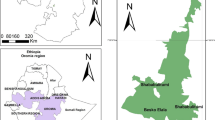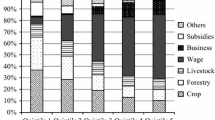Abstract
A new forest policy of allocating forestland to individual households for management and development, has been applied in Vietnam since the early 1990s. This study was designed to examine how local forest-related people have used forestland and forest resources under the new policy, and to determine their level of dependency on forests. An upland forest-related community in northern central Vietnam, where the policy was introduced in 2002, was chosen as a case study. It was found that local residents in the community have not complied with the forest allocation policy well, in that they violated the policy to freely lend forestland to and borrow from villagers for cropping purposes, regardless of whether they were rich or poor, had enough land or not, or were legally forest recipients. Regarding forest dependency, all households studied lived on forest resources (forestland and forest products). More than 65% of the total annual income of poorer households was derived from the forest, compared to less than 40% for the richer households. Forest-derived income accounted for more than 75% in their total income in some of the poorest households.


Similar content being viewed by others
Notes
Vietnam’s forests are functionally categorized into three classes: special-use, protection and production forests. Special-use forests are mainly used for the purpose of protecting nature, plants, animals and the ecosystems of the nation, scientific experimentation, maintaining historical and cultural relics, sight-seeing, and tourism. Protection forests are mainly used for protecting water and land resources, preventing erosion, limiting natural calamities, regulating the climate, and contributing to the protection of the ecological environment. Production forests are mainly used for the purpose of producing timber and non-timber forest products and specialties, and protecting the ecological environment (Sam and Trung 1999, cited in Vien et al. 2005). The special-use forest can also be managed by individual households, but only in very limited cases.
$1 US = 16,000 Vietnamese Dong (VND) approximately, as of October 2007.
More precisely, there are six kinds of forest (of the three functional categories) that can be allocated to local people: (1) Special-use forest, (2) Protection forest, (3) Forestland without forest cover but designated to be a protection forest, (4) Natural forest but designated to be a production forest, (5) Production forest which already has trees planted by the state’s investment, and (6) Production forest without forest trees (barren land). Timber cutting is forbidden in most forests unless people have permission from state authorities. Even when trees are ready for harvest, a permit from state authorities is still needed (except in cases where production forest recipients invest in forestry with their own money). Local people are allowed to take timber from production forest for building or repairing their own houses, as long as they have a permit from authorities (Articles 4, 5, 6, 7, 8, and 9 of Decision 178/DQ-TTg 2001).
As well as swidden (or slash-and-burn) land, this can be upland crop cultivation land used to grow upland rice, maize, cassava and other crops, with a fallow (non-cropping) period of just 1 to 2 years. In Vietnam in recent years the time left between crop years for land fertility recovery has declined from 10 to 15 years, due to lack of land.
Under the new Land Law promulgated on November 26, 2003, a Vietnamese community (or village or hamlet) having the same customs and/or kinship is officially eligible to be allocated land or to have land use rights (Point 3, Article 9, Land Law 2003). Since then the community forest management and traditional forest management systems have been promoted and encouraged.
The remainder of the production and protection forest area has been handed over to local organizations which are farmer associations, elderly unions, women’s associations, war veteran unions, and youth associations (DoNRE 2006).
The managers, which were formerly state-owned forest enterprises, are local Protection Forest Management Boards, at the district or regional level depending on the scale (area) and location (watershed area) of the protection forest.
This is a variation of the normal practice, in that the honorarium logically and normally is paid to those with a contract to manage protection forest, based on their area of protection forest.
Timber logging is illegal activity.
Under Article 15 of the Decree 02/CP 1994, the forestland recipient has the right to lend or even sell the land use certificate to others, though this will effect the subsidy and support from the government.
References
ABD, AusAID, DFID, GTZ, JICA, Save the Children UK, UNDP, and the World Bank (2003) Vietnam Development Report 2004: Poverty. Joint Donor Report to the Vietnam Consultative Group Meeting. 2–3 December 2003, Hanoi
Apel U (2000) Forest Protection Regulations as a Precondition for Natural Regeneration in the Song Da Watershed, Northwestern Vietnam. Paper presented at the Sustainable Rural Development in the Southeast Asian Mountainous Region Workshop organized by European Committee (EC), SIDA, GTZ, Hanoi
Apel U, Viet PV (1997) An Evaluation of the Forest Protection contracts and Regulations in Chieng Dong Commune, Yen Chau District. Working paper No. 7. Community Forestry Unit, Social Forestry Development Project (SFDP) Song Da and the Ministry of Agriculture and Rural Development-GTZ-GFA. Hanoi
Cari C (2005) On the Edge of Vietnam’s Forests. USLA International Institute. http://www.international.ucla.edu/print.asp?parentid=32863, accessed 18 November 2006
Castella JC, Boissau S, Thanh NH, Novosad P (2002) Impact of forestland allocation on agriculture and natural resources management in Bac Kan province, Vietnam. In: Castella JC, Quang DD (eds) Doi Moi in the mountains: land use changes and farmers’ livelihood strategies in Bac Kan province, Vietnam. Agricultural Publishing House, Hanoi, pp 197–220
CPC (Luu Kien Commune People’s Committee) (2006a) Census data. July 2006. Prepared by the commune to submit to district statistic division of district People’s Committee, Tuong Duong District, Nghe An province, Vietnam. Nghe An
CPC (2006b) Annual report 2005. Luu Kien Commune People’s Committee, Nghe An
Cuc LT, Rambo AT, Fahrney K, Vien TD, Romm J, Sy DT (1996) Red Books, Green Hills: The Impact of Economic Reform on Restoration Ecology in the Midlands of Northern Vietnam. CRES, Hanoi University. Southeast Asian Universities/Agroecosystem Network. East-West Center/Program on Environment, University of California, Berkeley
Decision 178/QD-TTg (2001) Rights of benefit sharing and obligations of the households and individuals on allocated and contracted forestland. The Central People’s Government, Hanoi
Decision 327/CT (1992) Policies for the use of bare lands, Denuded Hills, forests, Alluvial flats, and bodies of water. Council of Ministers, Hanoi
Decision 661/QD-TTg (1998) Objectives, tasks, policies and implementations of the five-million-hectare afforestation. The Central People’s Government, Hanoi
Decree 01/CP (1995) Enactment of regulations the allocation of land for agriculture, aquaculture, and forestry in state-run enterprises/farms to organizations, households and individuals for stable and long-term use. The Central People’s Government, Hanoi
Decree 02/CP (1994) Allocating of forestland to organizations, households and individuals for long-term forestry purposes. The Central People’s Government, Hanoi
Decree 163/ND-CP (1999) Allocating and leasing of forestland to organizations, households and individuals for long-term forestry purposes. The Central People’s Government, Hanoi
Decree 181/ND-CP (2004) Guidelines on the Implementation of the Land Law. The Central People’s Government, Hanoi
DoNRE (Department of Natural Resources and Environment) (2006) The six-month report. Tuong Duong District People’s Committee, Nghe An
FPD (Forest Protection Department) (2006) Annual report 2005. Forest Protection Department, Hanoi
Huy B (2003) Participatory technology development on natural forests allocated to the M’nong ethnic community. Social forestry support program. Tay Nguyen University, Tay Nguyen
Land Law (2003) National assembly. The National Political Publishing House, Hanoi
MARD (Ministry of Agriculture and Rural Development) (2000) Annual report 1999, Hanoi
MARD (Ministry of Agriculture and Rural Development) (2002) Forestry development strategy period 2001–2010. Translated by the Secretariat of the Five-million Hectare Reforestation Program Partnership, Hanoi
MARD )Ministry of Agriculture and Rural Development) (2003) Annual report 2002, Hanoi
Ngan LT, Tho NT (2000) Poverty situation of tay ethnic communities in Bac Giang. Hanoi Agricultural University, Hanoi (In Vietnamese)
Poffenberger M (2006) People in the forest: community forestry experiences from Southeast Asia. Int J Environment and Sustainable Development 5(1):57–69
Quang NV (2003) State policies and forest resource use in a Vietnamese Mountain Community. MSc Thesis, Ateneo de Manila University, Manila
Sam DD, Son HL, Trung LQ (2007) Forest governance in Vietnam. In: Decentralisation and state-sponsored community forestry in Asia. Institute for Global Environmental Strategies (IGES), pp 139–159
Sikor T (1998) Forest policy reform: from state to household forestry. In: Poffenberger M (ed) Stewards of Vietnam’s upland forests. Research Network Report Number 10, Asian Forestry Network, pp 118–138
Sikor T (2001) The allocation of forestry land in Vietnam: did it cause the expansion of forests in the northwest? J Forest Policy and Economics 2(1):1–11
Sunderlin WD, Ba HT (2005) Poverty alleviation and forests in Vietnam. Center for International Forestry Research (CIFOR), Bogor
Swinkels R, Turk C (2006) Explaining ethnic minority poverty in Vietnam: a summary of recent trends and current challenges. Background paper for Committee for Ethnic Minorities/Ministry of Planning and Investment. The World Bank, Hanoi
Tessier O (2002) World Bank Vietnam forestry sector development project: initial social screening. Tercia Consultants, Montpellier
Tuan KB (1998) Incentives for forest owners after forestland allocation in Thanh Hoa province. Thanh Hoa Province DARD, Thanh Hoa (In Vietnamese)
Vien TD, Quang NV, Thanh MV (2005) The impacts of decentralization of forest management and livelihoods of ethnic minority groups in the north-western and northern central uplands of Vietnam. The Agricultural Publishing House, Hanoi
Acknowledgments
The authors would like to thank the Fuji Xerox Setsutaro Kobayashi Memorial Fund and the Kyushu University Interdisciplinary Programs in Education and Projects in Research Development, for their financial support for the two field surveys of this research. Our special thanks also to farmers and officials in the study site. We gratefully acknowledge Steve Harrison from the University of Queensland, for his valuable comments and editing.
Author information
Authors and Affiliations
Corresponding author
Rights and permissions
About this article
Cite this article
Quang, N.V., Noriko, S. Forest Allocation Policy and Level of Forest Dependency of Economic Household Groups: A Case Study in Northern Central Vietnam. Small-scale Forestry 7, 49–66 (2008). https://doi.org/10.1007/s11842-008-9040-8
Received:
Accepted:
Published:
Issue Date:
DOI: https://doi.org/10.1007/s11842-008-9040-8




